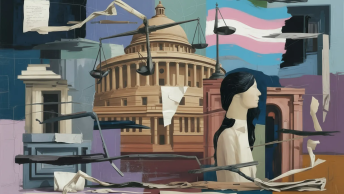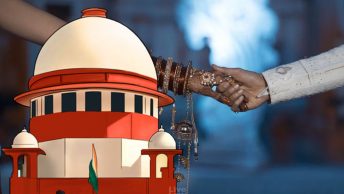[Ed Note: This piece has been published on an evolving situation with all updates till 5:00pm, 9th September having been accounted for. LAOT invites responses to the arguments made in this piece, both through our comments section as well as through a new post. We shall also publish any official response or link any new Press Release as and when we’re informed of it or come across it. It is also clarified that the views expressed are solely of the authors, in their personal capacity.
Authors Note: We are extremely grateful to Vishal Rakhecha & members of the LAOT Editorial Board for their continuous assistance and editorial comments over the last two days which have helped us to significantly improve our initial draft.]
National Law School of India University, Bangalore (NLSIU) notified that it shall conduct its own examination, National Law Aptitude Test (“NLAT”) on 12 September 2020. In Part I, we looked at the legality of NLSIU’s decision of having a separate entrance test while continuing as a member of the Consortium of NLUs which conducts CLAT.
The test prima facie promises safety for all applicants as they can appear for it from their homes through an online interface. However, in this part, we shall analyze the mode and timeline of the examination to argue that contrary to the Notification’s claims, the examination is not fair, accessible or transparent.
Transparency & Accountability
According to the Notification, applicants who successfully appear for the test will be individually informed of their result via text message/ email. The university has declined to publish a consolidated merit list of students. This is problematic due to two reasons. First, in FAQs, NLS has justified non-publication of a complete merit list of all examinees on grounds of data-privacy data concern. The same justification has also been provided for refusing to mention the score in the provisional admission list, which will only include names and ranks. However, other key privacy concerns which may arise in the examination process have not been addressed by NLSIU. The FAQs clarify that NLAT shall employ a combination of Artificial Intelligence and human-based proctoring. But they are completely silent on the privacy policy of its proctoring technologies/ service providers. Additionally, the lack of privacy safeguards in the examination process is evidenced by the use of AI Proctoring, which has been often criticised by experts. It is surprising that on one hand NLSIU claims that “marks secured by other students are personal information protected from disclosure” but on the other hand, it does not say anything about the privacy policy of its proctoring service provider and rather does not even mention the service provider’s details.
Second, the importance of transparency in entrance examinations, especially through merit lists, has been well-recognized by the judiciary. It is a well-established common practice to publish the merit list publicly to ensure transparency. This is in line with the student-welfare centric nature of entrance examinations and to ensure that they should not be made to suffer due to organizer’s mistakes. Thus, potential errors in the merit list must be rectified to ensure complete fairness. However, such rectification becomes difficult in NLAT due to non-publication of a consolidated merit list.
Further, through the examination notification, NLSIU has exempted its decisions w.r.t. applicant’s eligibility, candidature, shortlisting or selection from appeal or challenges. It has also reserved powers to unilaterally alter, modify, or cancel any component or stage of the selection process without prior notice.
This wide power has already been seemingly exercised. The NLAT notification specifies that the merit list will be formed “solely on basis of their marks in the NLAT 2020 UG” and a marking scheme has been laid out without any mention of moderation or normalizationation procedures post conduct of exam. However, the FAQs mention that as the test would be conducted in three sessions and while it shall take “all efforts to maintain equivalence among various question papers, the difficulty level of the question papers…may not exactly be the same. Hence, a Normalization procedure will be used to compile law scores across batches.” Such normalization procedure was nowhere mentioned in the initial notification, and would be a modification from the claim in the notified procedure wherein merit list would have been prepared solely on the basis of the marks obtained. Not only do such broad exemptions make it difficult for applicants to understand the exact examination process, it is also questionable if a Notification can be altered through FAQs!
The accountability concerns with the examination are further increased if its timeline is considered. It effectively gives applicants seven days to register themselves and two days to file any objections to the provisional answer key. The provisional admission list shall be announced five days after the examination, merely three days after which the academic session of NLSIU shall begin and will not even mention the marks secured by selected students. This effectively leaves applicants and other stakeholders with barely any time to judicially challenge any aspect of the examination process.
The lack of adequate time becomes a crucial issue if judicial precedents are considered. In CLAT 2012, numerous questions were out-of-syllabus, which was challenged in Ujjwal Madan and Others v Union of India. But the Delhi High Court chose to not interfere with the process despite clear evidence of such allegations because it considered that the petition was premature as results were not yet announced and petitioners were free to bring this claim once results are out. However, when another case (Shivangi Gupta v NLU, Jodhpur) concerning the same situation was filed in the court after the result declaration, the court ruled that it shall not interfere with the results or admission process as the admission process was already complete and selected students had already deposited fees. This example clearly shows that even the 2-3 weeks long window between results and admissions during CLAT was also too less for anyone to successfully challenge the examination procedure and results in the court. The three-day window in NLAT would effectively negate the possibility of a meaningful judicial challenge, and leave no recourse to those whose rights have been gravely violated by the exam. In the past, there have been instances wherein though the court recognized that the student missed a better rank due to examination authority’s error, justice was still not done as a year had passed since the examination and there was no vacancy in petitioner’s choice of university.
Though the NLAT Examination Authority has justified such issues on grounds of their time constraints caused by trimester format, it is important to remember that administrative reasons should not form the basis to effectively negate the applicants’ right of challenging the process. Is it really moving ahead when it is at the cost of inclusion of the already excluded?
Technological Challenges
The original technical requirements for appearing for the examination required applicants to use a Personal Computer (Desktop or Laptop) running with Windows 7 or above with an updated version of Google Chrome web browser. However, through a notification dated 7 September 2020, NLSIU has relaxed multiple technical requirements (for example, allowing attached webcams, allowing the exam to be taken on Android Phones as well as Mac or Linux OS etc.) and also offered test centers. While this has solved certain issues, many remain that we analyze.
According to a survey conducted in 2018 by the National Statistical Office, only 11% of households in India had a Personal Computer, and it can be reasonably concluded that many of these are unlikely to have a webcam. This means a very small portion of households where children have the technology can appear using the same. Yesterday, NLSIU notified that students will be allowed to take the test on Android smartphones. This makes the test comparatively more accessible as the penetration of smartphones among diverse Indian demographics is significantly higher than personal computers.
However, in our opinion, it does not substantially tackle the discriminatory access issues. This is because NLAT gives merely 45-minutes to answer 40 questions based on four long comprehension passages. Reading and switching questions and moving to different portions of a long comprehension passage, on a smartphone screen will automatically be more time-consuming as compared to a computer screen. Therefore, someone using an android phone due to lack of access to a computer is bound to already start at a disadvantage.
There are arguments that students could visit cyber cafes and take the test. However, this does not address the hardships faced by underprivileged students because a cybercafe also hardly provides the kind of privacy and silence that a test-taker needs while giving an entrance exam. Rather, Rule 6 of the Information Technology (Guidelines for Cyber Cafe) Rules, 2011 does not even allow minors, who might form a portion of test-takers, being given cubicles which might allow a better test-taking environment, unless the minor is accompanied by guardian or parents which however the exam’s video proctoring would possibly not allow.
NLSIU seems to have taken a step towards increasing accessibility by notifying 14 ‘test centres’ in collaboration with a private organiser Testpan India Pvt. Ltd. However, surprisingly the NLAT website states that:
“Please note that the NLSIU is not responsible for technical problems, internet outages or any other issues that may arise at Testpan centres. The arrangement is a private agreement between Testpan and the candidate and NLSIU does not bear any liability in relation to the same.”
Such a disclaimer is striking because if NLSIU itself is unable to guarantee and stand behind the test centre provider it has informed applicants about, how can the applicants be confident in relying on such a provider? CLAT 2018 was marred by multiple technical issues due to their chosen service provider The issues were to such an extent that CLAT moved to a pen-paper test citing them 2018 onwards. Resultantly, if students face any issue which impairs their ability to perform in the examination at Testpan centers, NLSIU will be able to continue with the admission process unhindered and applicants will effectively be left with prolonged litigation against a private actor.
Further, these Testpan centres are currently available only in 14 states. Along with many other States, West Bengal does not have a Testpan centre. Given that it shall be under complete lockdown on the day of NLAT, cyber cafes will also not be functional. Effectively, any applicant without their personal technological arrangements (namely device and internet bandwidth) will be rendered incapable of appearing for the examination. Thus, though the test centre option does prima facie address access issues, many loopholes are still evident and the manner of implementation will ultimately decide its positive effect.
Given that the quality of device and internet available with an applicant is greatly dependent on their location within the country, as well as socio-economic background; the likelihood of an underprivileged student facing such problems is drastically higher than a financially stronger candidate. The Supreme Court has observed that “the opportunity to acquire education cannot be limited to richer sections of the society.” NLAT’s plan, structure and technical requirements disproportionately disadvantages the under-privileged students and hinders their opportunity to compete for the examination at a level playing field. It is a settled position of law that the court may interfere with entrance examinations when the situation violates any law, is coloured by mala fide or other ulterior motives, or is arbitrary, whimsical and lacks reasonable explanation. The above arguments make a case for judicial intervention to consider whether the solution being taken by NLSIU is justified, especially in light of the equality trade-offs it makes.
Conclusion
Indian legal education is crowded with various functional problems, including lack of a diverse student body within the National Law Universities, and is often chided for its elitist and exclusionary nature. The exclusionary nature of NLAT is a step backwards from attempts to enrich diversity. NLSIU seems to be recognizing this, possibly owing to public discourse since the notification was released, and has taken stop-gap measures by setting up test centres and relaxing technical requirements to make the test accessible across other devices. However, it is questionable how effective these test centres would be, especially considering that NLSIU has negated liability for technical issues faced while sitting for the test through them.
This also indicates that the examination structure was potentially not well-planned since the beginning with such changes having to take place with less than 100 hours to the exam and 36 hours to the registration deadline. The move also jeopardizes its relationship with the Consortium of NLUs, a Consortium which had based its permanent secretariat at NLSIU. As we had analyzed in Part 1, its claim of being able to continue as a Consortium member while admitting students through a separate test is questionable.
The NLSIU Student Body has recognized the hardships and is assisting access issues faced by applicants. Such applicants can fill this Google Form to get in touch with the student body. You can also reach out to them at laptopsfornlat@gmail.com. If you are willing to lend your laptop/ webcam/ dongle/ space to interested applicants facing access issues, please fill this Google Form and the Student Body shall put you in touch with the aspirant.
[Authors Update 1 (3:00 PM, 10th September, 2020): West Bengal Government has taken the decision to cancel the lockdown on 12th September in light of the NEET 2020 Examination scheduled for 13th September to allow students to travel to their test centres. Hon’ble CM, West Bengal has tweeted at 1:36 PM, 10th September. 2020 that: GoWB had initially announced a statewide lockdown on Sep 11th & 12th. Considering the NEET 2020 examination scheduled on 13th, we have received numerous requests from the student community on lifting lockdown norms on 12th, helping ease their travel to examination centres. (1/2) Keeping their interest in mind, while keeping the statewide lockdown as it is on Sep 11th, it has been decided to cancel the lockdown on 12th, so that the students can attend the examination on 13th without any apprehensions or concerns. I wish them all the very best. (2/2)
NLSIU has also updated the test centre being offered by Testpan to 33 centres across multiple States. The list is evolving on an on-going basis and it notes that candidates who wish to explore this option may also contact Mr. Yogender Chauhan, Testpan India Pvt. Ltd., +91 7428461194 and are requested to send an email at info@testpanindia.com mentioning their name, number, email id and the current city.
Yesterday, NLSIU also notified Proctoring Protocol which can be accessed here. A commentator below has put forth their views on the same.]








Thanks for putting it out there and generating a discourse concerning the same. Just a correction- Currently the centres are located only in 12 states with Rajasthan and UP having 2 centres each. Additionally, there’s another string of argument that could be fleshed out more, something I haven’t seen to be discussed much so far. In addition to the fact that a large section of the society doesn’t have access to 512 kbps internet, with stories from several states of people travelling miles and climbing on trees to get some connectivity, feasibility of giving the exam on a phone is uncertain. There would naturally be a lot of movement in a phone while writing the test answers and that would in turn lead to a greater possibility of them be called out by the proctors as it seems from the privacy breaching guidelines that they have released for the same. Moreover, it is almost impossible for majority of the applicants to ensure that there is no nearby sound, many do not have access to quiet place in their homes and going anywhere outside would mean (a) risking health amidst the pandemic and (b) no control over the nearby noises and surroundings. With the prescribed proctoring guidelines such students would just be penalised due to noises around them. The recent NLSIU administration has never failed to disappoint with elitist policies, be it the NLAT or their stance on student scholarships, it is important that these discriminatory practices are highlighted.
Thanks for sharing. I read many of your blog posts, cool, your blog is very good. https://accounts.binance.com/tr/register-person?ref=W0BCQMF1